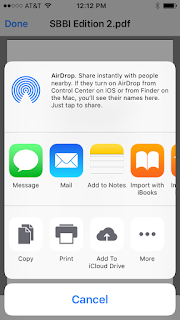This post was originally posted on June 7, 2017
Recently, I had to take a long road trip. I decided to proofread while my husband drove. By sending the document to my iPhone, I realized that seeing it on the smaller screen highlighted certain errors. It also gave me a feel for how the e-book version would look on a mobile device.
1. Save your document as a PDF from Word. If you do not have this option with your word processing program, you may be able to upload the word document itself or convert the word document through another source, such as Nuance PDF or Adobe online.
2. Email it to yourself.
3. Open the email on your phone.
4. Upload the PDF to iBooks or other PDF reader.
Note: iBooks allows you to annotate.
4. Read and take notes.
5. Update your draft.
Keep proofreading until you can't find any mistakes. It helps to have other people read the final draft as well. They catch things you cannot because you have read it so many times.
Especially if you self-publish, I recommend having a professional editor look over your manuscript, even if you aced grammar in high school or college. If you don't have access to one or can't afford one, then thorough proofreading is your best weapon.
I would not waste time with endless proofreading passes until you are certain your story is complete and ready to be spit-shined. That said, proofreading may uncover problems you didn't realize you had. Consider picking up a copy of Story Building Blocks III: The Revision Layers. It will guide you through multiple proofreading and revision passes before you reach the final proofreading stage.
If you have enough time, put the final draft away for a week or even a month. Go back and look at it again with fresh eyes. Bribe friends, family, or critique partners into giving it a once over if possible.
When you self-publish, it is critical to eliminate 99% of errors. I would say 100%, but even traditionally published books have a few typos nowadays. A book full of typos earns negative reviews and costs you fans.
Presenting a clean manuscript to an agent or editor can lift you to the top of the slush pile. If you present your manuscript for a professional critique or pitch at a conference, the agent will look favorably upon you. It is a relief to find a smooth submission as opposed to one riddled with typos and gross abuse of language.
Editors have been thinned out even at the large publishing houses. Clean manuscripts make an editor's job easier, which makes your project more desirable.
 |
Diana Hurwitz is the author of Story Building Blocks: The Four Layers of Conflict, Story Building Blocks II: Crafting Believable Conflict, Story Building Blocks III: The Revision Layers, and the YA adventure series Mythikas Island. Her weekly blog, Game On: Crafting Believable Conflict explores how characters behave and misbehave. Visit DianaHurwitz.com for more information and free writing tools. You can follow her on Facebook and Twitter.
|









More great info about the necessity of careful proofreading. A clean manuscript (99-100% error free) may seem like a small thing, but it's huge when it comes to placing a competitive book on the shelf in that huge bookstore in the cloud. :-)
ReplyDelete